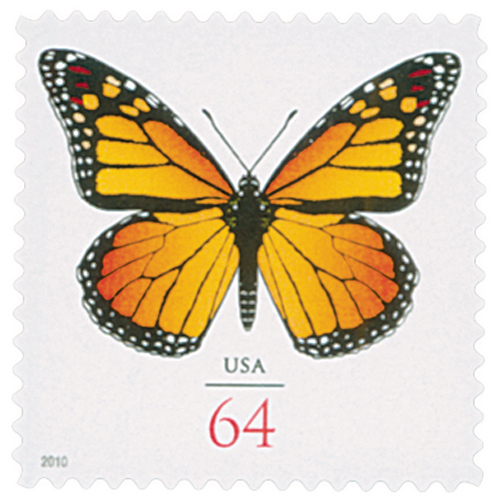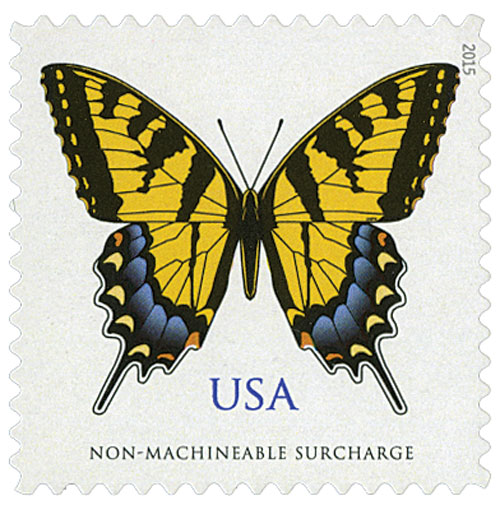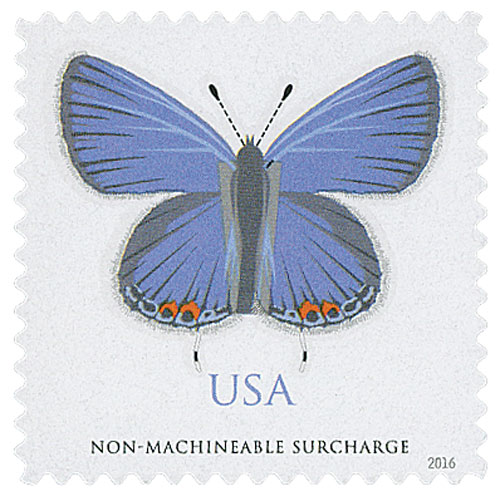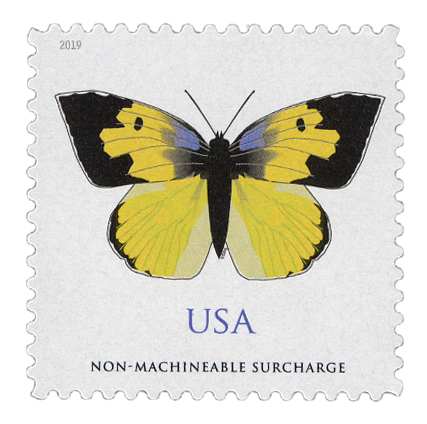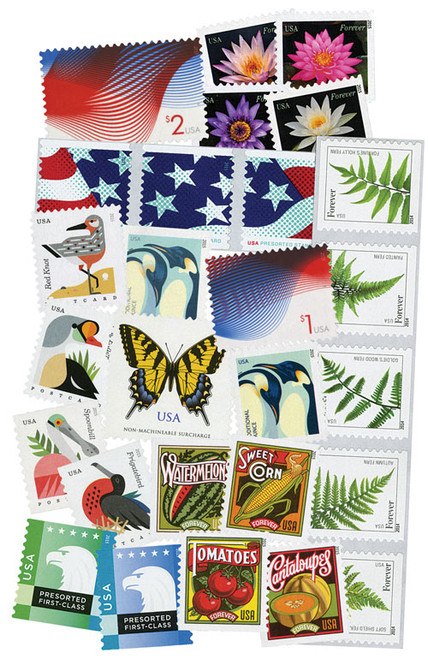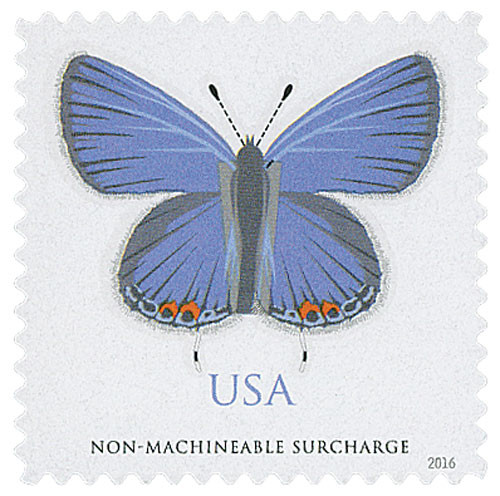
# 4999 - 2015 71c Eastern Tiger Swallowtail Butterfly
U.S. # 4999
2015 71¢ Eastern Tiger Swallowtail
Butterfly Series
In 1587, colonist and artist John White depicted the Eastern tiger swallowtail while accompanying Sir Walter Raleigh’s third expedition to the New World. It was the first butterfly known to have been documented in the United States.
One of the most common butterflies in North America, the Eastern tiger swallowtail is also one of the largest. Its wingspan can measure up to five and a half inches across. From spring until fall, gardens, forests and meadows across the Eastern United States are dappled with these light yellow tiger-striped butterflies.
Not all Eastern tiger swallowtails are yellow with black stripes. A minority of females take on a dark gray coloring, with their tiger stripes barely visible. The darker coloring protects the butterfly from potential predators by mimicking the poisonous pipevine swallowtail. The trait is more prevalent in tiger swallowtails in the southeast, where the pipevine swallowtail is common.
Though it flies relatively fast, the Eastern tiger swallowtail beats its wings rather slowly, allowing watchers to better appreciate its beauty. Named state butterfly of five states and state insect in another, the large but delicate Eastern tiger swallowtail is a favorite in the Eastern United States.
Butterfly Series
In late 2009, the USPS unveiled the first butterfly stamp for greeting card envelopes that required additional postage (an extra 20¢) than the standard one-ounce rate covered. This would apply to envelopes that couldn’t be sorted on the USPS’s automated equipment, otherwise known as “nonmachinable.”
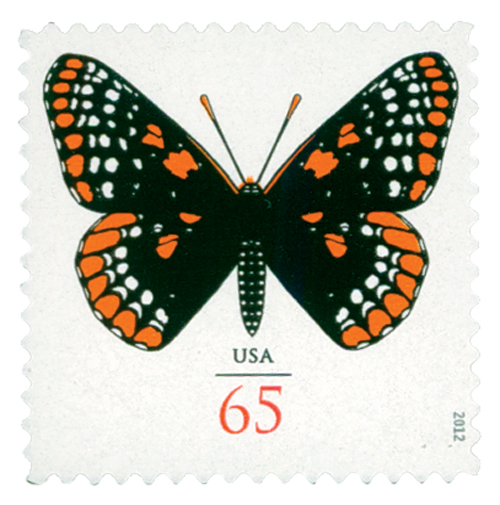
Some of these nonmachinable envelopes include those that are oddly-shaped or vertical, lumpy, rigid, or with clasps, ribbons, or buttons on them. Even if an envelope weighed less than one ounce, but was unmachinable, it would need this stamp. However, letters that were simply heavy didn’t necessarily need it. The two-ounce rate at the time was 61¢, and this stamp was 64¢, so they would be overpaying by 3¢ if they used it.
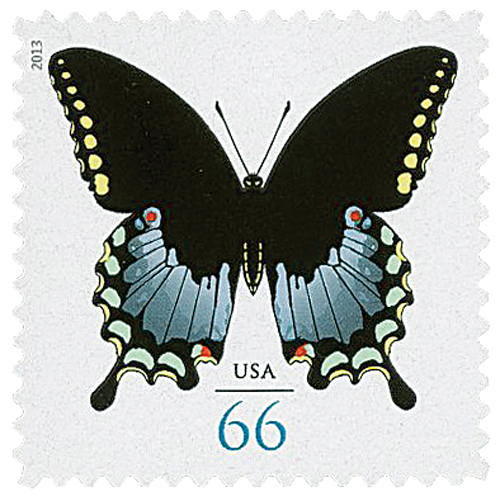
The USPS worked closely with the greeting card industry on this new stamp. Prior to this issue, some greeting card envelopes would be imprinted with “extra postage required.” With the creation of this new stamp, the Greeting Card Association encouraged its members to print a butterfly silhouette on the envelopes of cards that would require this additional postage. Reflecting this close working relationship, the 64¢ monarch butterfly stamp was issued on May 17, 2010, at the National Stationery Show held at the Jacob Javits Center in New York.
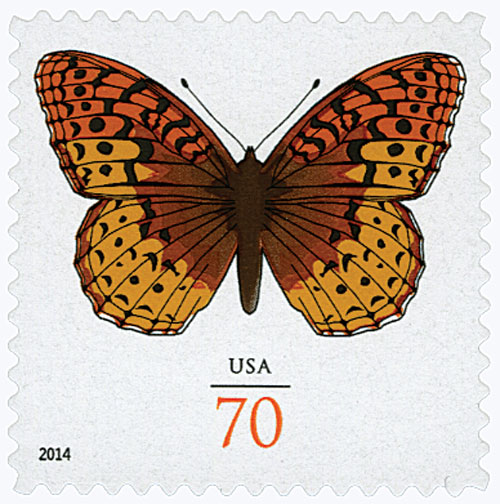
The monarch stamp remained in use for two years, being replaced by the Baltimore checkerspot butterfly stamp in 2012 when the nonmachinable rate increased to 65¢. New stamps were issued each year through 2016. The 2015 and 2016 followed the Forever format, in printing “non-machinable surcharge” on the stamp, rather than the actual denomination.
The California dogface butterfly stamp was initially announced in 2016 and expected for a 2017 release. However, the USPS said that they had designed the stamp, but wouldn’t produce it until supplies of existing butterfly stamps were nearly depleted. So that stamp wasn’t issued until 2019.
Click here to view lots more US and worldwide butterfly stamps.
U.S. # 4999
2015 71¢ Eastern Tiger Swallowtail
Butterfly Series
In 1587, colonist and artist John White depicted the Eastern tiger swallowtail while accompanying Sir Walter Raleigh’s third expedition to the New World. It was the first butterfly known to have been documented in the United States.
One of the most common butterflies in North America, the Eastern tiger swallowtail is also one of the largest. Its wingspan can measure up to five and a half inches across. From spring until fall, gardens, forests and meadows across the Eastern United States are dappled with these light yellow tiger-striped butterflies.
Not all Eastern tiger swallowtails are yellow with black stripes. A minority of females take on a dark gray coloring, with their tiger stripes barely visible. The darker coloring protects the butterfly from potential predators by mimicking the poisonous pipevine swallowtail. The trait is more prevalent in tiger swallowtails in the southeast, where the pipevine swallowtail is common.
Though it flies relatively fast, the Eastern tiger swallowtail beats its wings rather slowly, allowing watchers to better appreciate its beauty. Named state butterfly of five states and state insect in another, the large but delicate Eastern tiger swallowtail is a favorite in the Eastern United States.
Butterfly Series
In late 2009, the USPS unveiled the first butterfly stamp for greeting card envelopes that required additional postage (an extra 20¢) than the standard one-ounce rate covered. This would apply to envelopes that couldn’t be sorted on the USPS’s automated equipment, otherwise known as “nonmachinable.”

Some of these nonmachinable envelopes include those that are oddly-shaped or vertical, lumpy, rigid, or with clasps, ribbons, or buttons on them. Even if an envelope weighed less than one ounce, but was unmachinable, it would need this stamp. However, letters that were simply heavy didn’t necessarily need it. The two-ounce rate at the time was 61¢, and this stamp was 64¢, so they would be overpaying by 3¢ if they used it.

The USPS worked closely with the greeting card industry on this new stamp. Prior to this issue, some greeting card envelopes would be imprinted with “extra postage required.” With the creation of this new stamp, the Greeting Card Association encouraged its members to print a butterfly silhouette on the envelopes of cards that would require this additional postage. Reflecting this close working relationship, the 64¢ monarch butterfly stamp was issued on May 17, 2010, at the National Stationery Show held at the Jacob Javits Center in New York.

The monarch stamp remained in use for two years, being replaced by the Baltimore checkerspot butterfly stamp in 2012 when the nonmachinable rate increased to 65¢. New stamps were issued each year through 2016. The 2015 and 2016 followed the Forever format, in printing “non-machinable surcharge” on the stamp, rather than the actual denomination.
The California dogface butterfly stamp was initially announced in 2016 and expected for a 2017 release. However, the USPS said that they had designed the stamp, but wouldn’t produce it until supplies of existing butterfly stamps were nearly depleted. So that stamp wasn’t issued until 2019.
Click here to view lots more US and worldwide butterfly stamps.













